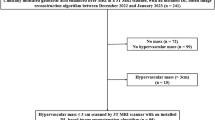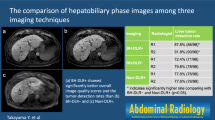Abstract
Purpose
To evaluate the efficacy of a vendor-specific deep learning reconstruction algorithm (DLRA) in enhancing image quality and focal lesion detection using three-dimensional T1-weighted gradient-echo images in gadoxetic acid-enhanced liver magnetic resonance imaging (MRI) in patients at a high risk of hepatocellular carcinoma.
Materials and methods
In this retrospective analysis, 83 high-risk patients with hepatocellular carcinoma underwent gadoxetic acid-enhanced liver MRI using a 3-T scanner. Triple arterial phase, high-resolution portal venous phase, and high-resolution hepatobiliary phase images were reconstructed using conventional reconstruction techniques and DLRA (AIRTM Recon DL; GE Healthcare) for subsequent comparison. Image quality and solid focal lesion detection were assessed by three abdominal radiologists and compared between conventional and DL methods. Focal liver lesion detection was evaluated using figures of merit (FOMs) from a jackknife alternative free-response receiver operating characteristic analysis on a per-lesion basis.
Results
DLRA-reconstructed images exhibited significantly improved overall image quality, image contrast, lesion conspicuity, vessel conspicuity, and liver edge sharpness and reduced subjective image noise, ringing artifacts, and motion artifacts compared to conventionally reconstructed images (all P < 0.05). Although there was no significant difference in the FOMs of non-cystic focal liver lesions between the conventional and DL methods, DLRA-reconstructed images showed notably higher pooled sensitivity than conventionally reconstructed images (P < 0.05) in all phases and higher detection rates for viable post-treatment HCCs in the arterial and hepatobiliary phases (all P < 0.05).
Conclusions
Implementing DLRA can enhance the image quality in 3D T1-weighted gradient-echo sequences of gadoxetic acid-enhanced liver MRI examinations, leading to improved detection of viable post-treatment HCCs.
Graphical abstract




Similar content being viewed by others
Data availability
The datasets generated or analyzed during the study are not publicly available due to the patients’ personal medical information but are available from the corresponding author on reasonable request.
References
El-Serag HB. Hepatocellular carcinoma. N Engl J Med. 2011;365(12):1118–27. https://doi.org/10.1056/NEJMra1001683.
Chernyak V, Fowler KJ, Kamaya A, Kielar AZ, Elsayes KM, Bashir MR, et al. Liver Imaging Reporting and Data System (LI-RADS) Version 2018: Imaging of Hepatocellular Carcinoma in At-Risk Patients. Radiology. 2018;289(3):816–30. https://doi.org/10.1148/radiol.2018181494.
European Association for the Study of the Liver. Electronic address eee, European Association for the Study of the L. EASL Clinical Practice Guidelines: Management of hepatocellular carcinoma. J Hepatol. 2018;69(1):182–236. https://doi.org/10.1016/j.jhep.2018.03.019.
Omata M, Cheng AL, Kokudo N, Kudo M, Lee JM, Jia J, et al. Asia–Pacific clinical practice guidelines on the management of hepatocellular carcinoma: a 2017 update. Hepatology International. 2017;11(4):317–70. https://doi.org/10.1007/s12072-017-9799-9.
Korean Liver Cancer A, National Cancer Center K. 2022 KLCA-NCC Korea Practice Guidelines for the Management of Hepatocellular Carcinoma. Korean Journal of Radiology. 2022;23(12):1126–240. https://doi.org/10.3348/kjr.2022.0822.
Roberts LR, Sirlin CB, Zaiem F, Almasri J, Prokop LJ, Heimbach JK, et al. Imaging for the diagnosis of hepatocellular carcinoma: A systematic review and meta-analysis. Hepatology. 2018;67(1):401–21. https://doi.org/10.1002/hep.29487.
Jang EB, Kim DW, Choi SH, Hong SB, Park T, Ko Y, et al. Transient severe motion artifacts on gadoxetic acid-enhanced MRI: risk factor analysis in 2230 patients. Eur Radiol. 2022;32(12):8629–38. https://doi.org/10.1007/s00330-022-08885-2.
Yoon JH, Lee JM, Yu MH, Kim EJ, Han JK. Triple Arterial Phase MR Imaging with Gadoxetic Acid Using a Combination of Contrast Enhanced Time Robust Angiography, Keyhole, and Viewsharing Techniques and Two-Dimensional Parallel Imaging in Comparison with Conventional Single Arterial Phase. Korean Journal of Radiology. 2016;17(4):522–32.https://doi.org/10.3348/kjr.2016.17.4.522.
Nam JG, Lee JM, Lee SM, Kang HJ, Lee ES, Hur BY, et al. High Acceleration Three-Dimensional T1-Weighted Dual Echo Dixon Hepatobiliary Phase Imaging Using Compressed Sensing-Sensitivity Encoding: Comparison of Image Quality and Solid Lesion Detectability with the Standard T1-Weighted Sequence. Korean Journal of Radiology. 2019;20(3):438–48. https://doi.org/10.3348/kjr.2018.0310.
Kim JH, Yoon JH, Bae JS, Park S, Han S, Lee JM. Multiarterial Phase Acquisition in Gadoxetic Acid-Enhanced Liver MRI for the Detection of Hypervascular Hepatocellular Carcinoma in High-Risk Patients: Comparison of Compressed Sensing Versus View Sharing Techniques. Invest Radiol. 2023;58(2):139–47. https://doi.org/10.1097/RLI.0000000000000910.
Montalt-Tordera J, Muthurangu V, Hauptmann A, Steeden JA. Machine learning in Magnetic Resonance Imaging: Image reconstruction. Phys Med. 2021;83:79–87. https://doi.org/10.1016/j.ejmp.2021.02.020.
Gore JC. Artificial intelligence in medical imaging. Magn Reson Imaging. 2020;68:A1–A4. https://doi.org/10.1016/j.mri.2019.12.006.
Mazurowski MA, Buda M, Saha A, Bashir MR. Deep learning in radiology: An overview of the concepts and a survey of the state of the art with focus on MRI. J Magn Reson Imaging. 2019;49(4):939–54. https://doi.org/10.1002/jmri.26534.
Lebel RM. Performance characterization of a novel deep learning-based MR image reconstruction pipeline. ArXiv. 2020; http://arxiv.org/abs/2008.06559.
Wessling D, Herrmann J, Afat S, Nickel D, Almansour H, Keller G, et al. Application of a Deep Learning Algorithm for Combined Super-Resolution and Partial Fourier Reconstruction Including Time Reduction in T1-Weighted Precontrast and Postcontrast Gradient Echo Imaging of Abdominopelvic MR Imaging. Diagnostics (Basel). 2022;12(10). https://doi.org/10.3390/diagnostics12102370.
Almansour H, Herrmann J, Gassenmaier S, Lingg A, Nickel MD, Kannengiesser S, et al. Combined Deep Learning-based Super-Resolution and Partial Fourier Reconstruction for Gradient Echo Sequences in Abdominal MRI at 3 Tesla: Shortening Breath-Hold Time and Improving Image Sharpness and Lesion Conspicuity. Acad Radiol. 2022. https://doi.org/10.1016/j.acra.2022.06.003.
Hahn S, Yi J, Lee HJ, Lee Y, Lim YJ, Bang JY, et al. Image Quality and Diagnostic Performance of Accelerated Shoulder MRI With Deep Learning-Based Reconstruction. AJR Am J Roentgenol. 2022;218(3):506–16. https://doi.org/10.2214/AJR.21.26577.
Lee DH, Park JE, Nam YK, Lee J, Kim S, Kim YH, et al. Deep learning-based thin-section MRI reconstruction improves tumour detection and delineation in pre- and post-treatment pituitary adenoma. Sci Rep. 2021;11(1):21302. https://doi.org/10.1038/s41598-021-00558-2.
Wang X, Ma J, Bhosale P, Ibarra Rovira JJ, Qayyum A, Sun J, et al. Novel deep learning-based noise reduction technique for prostate magnetic resonance imaging. Abdom Radiol (NY). 2021;46(7):3378–86. https://doi.org/10.1007/s00261-021-02964-6.
Sun S, Tan ET, Mintz DN, Sahr M, Endo Y, Nguyen J, et al. Evaluation of deep learning reconstructed high-resolution 3D lumbar spine MRI. Eur Radiol. 2022;32(9):6167–77. https://doi.org/10.1007/s00330-022-08708-4.
Chazen JL, Tan ET, Fiore J, Nguyen JT, Sun S, Sneag DB. Rapid lumbar MRI protocol using 3D imaging and deep learning reconstruction. Skeletal Radiol. 2023. https://doi.org/10.1007/s00256-022-04268-2.
Son JH, Lee Y, Lee HJ, Lee J, Kim H, Lebel MR. LAVA HyperSense and deep-learning reconstruction for near-isotropic (3D) enhanced magnetic resonance enterography in patients with Crohn's disease: utility in noise reduction and image quality improvement. Diagn Interv Radiol. 2023. https://doi.org/10.4274/dir.2023.232113.
Liver Imaging Reporting and Data System [Internet]. [cited February 7, 2023]. Available from: https://www.acr.org/Clinical-Resources/Reporting-and-Data-Systems/LI-RADS.
Kielar A, Fowler KJ, Lewis S, Yaghmai V, Miller FH, Yarmohammadi H, et al. Locoregional therapies for hepatocellular carcinoma and the new LI-RADS treatment response algorithm. Abdom Radiol (NY). 2018;43(1):218–30. https://doi.org/10.1007/s00261-017-1281-6.
Hillis SL. A comparison of denominator degrees of freedom methods for multiple observer ROC analysis. Statistics in Medicine. 2007;26(3):596–619. https://doi.org/10.1002/sim.2532.
Dorfman DD, Berbaum KS, Metz CE. Receiver operating characteristic rating analysis. Generalization to the population of readers and patients with the jackknife method. Invest Radiol. 1992;27(9):723–31.
Wongpakaran N, Wongpakaran T, Wedding D, Gwet KL. A comparison of Cohen's Kappa and Gwet's AC1 when calculating inter-rater reliability coefficients: a study conducted with personality disorder samples. BMC Medical Research Methodology. 2013;13:61. https://doi.org/10.1186/1471-2288-13-61.
Landis JR, Koch GG. The measurement of observer agreement for categorical data. Biometrics. 1977;33(1):159–74.
Kim DW, Choi SH, Park T, Kim SY, Lee SS, Byun JH. Transient Severe Motion Artifact on Arterial Phase in Gadoxetic Acid-Enhanced Liver Magnetic Resonance Imaging: A Systematic Review and Meta-analysis. Invest Radiol. 2022;57(1):62–70. https://doi.org/10.1097/RLI.0000000000000806.
Acknowledgments
Statistical analyses were supported by Medical Research Collaborating Center (MRCC) of Seoul National University Hospital.
Funding
This work was supported by GE Healthcare (Project Number: 0620216290).
Author information
Authors and Affiliations
Contributions
Conceptualization: J.M.L. Data curation: J.H.K. Formal analysis: J.H.K. Funding acquisition: N/A. Investigation: S.W.K, J.P, S.H.B. Methodology: J.M.L., J.H.Y., J.H.K. Project administration: J.M.L. Resources: J.M.L. Software: N/A. Supervision: J.M.L., J.H.Y. Validation: N/A. Visualization: J.H.K. Writing-original draft: J.M.L., J.H.K. Writing-review and editing: J.M.L, J.H.Y, J.H.K.
Corresponding author
Ethics declarations
Conflict of interest
We received technical support from GE Healthcare for the submitted work. J.M.L. has received grants from Bayer Healthcare, Canon Healthcare, Philips Heathcare, GE Healthcare, CMS, Guerbet, Samsung Medison, and Bracco. J.M.L. has received personal fees from Bayer Healthcare, Siemens Healthineer, Samsung Medison, Guerbet, and Philips Healthcare. J.H.Y. has received honorarium from Bayer Healthcare and personal fee from Philips Healthcare. For the remaining authors none were declared.
Additional information
Publisher's Note
Springer Nature remains neutral with regard to jurisdictional claims in published maps and institutional affiliations.
Supplementary Information
Below is the link to the electronic supplementary material.
Rights and permissions
Springer Nature or its licensor (e.g. a society or other partner) holds exclusive rights to this article under a publishing agreement with the author(s) or other rightsholder(s); author self-archiving of the accepted manuscript version of this article is solely governed by the terms of such publishing agreement and applicable law.
About this article
Cite this article
Kim, J.H., Yoon, J.H., Kim, S.W. et al. Application of a deep learning algorithm for three-dimensional T1-weighted gradient-echo imaging of gadoxetic acid-enhanced MRI in patients at a high risk of hepatocellular carcinoma. Abdom Radiol 49, 738–747 (2024). https://doi.org/10.1007/s00261-023-04124-4
Received:
Revised:
Accepted:
Published:
Issue Date:
DOI: https://doi.org/10.1007/s00261-023-04124-4




